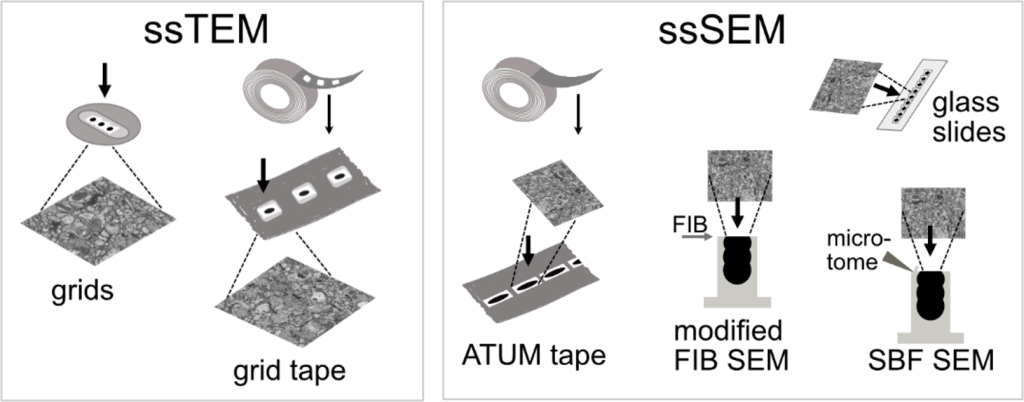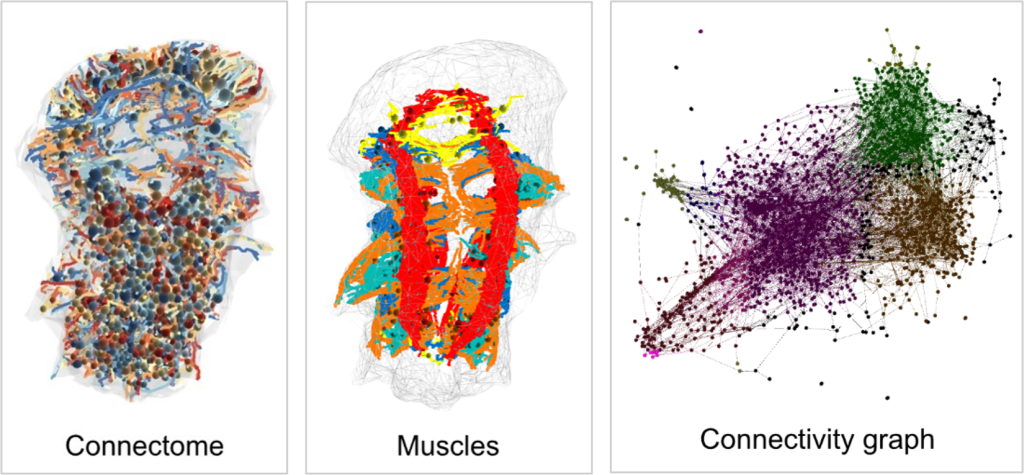How volumeEM (vEM) can help map neuronal circuits
Posted by FocalPlane, on 2 March 2022
by Nadine Randel, University of Cambridge, UK
DOI:10.5281/zenodo.6320414
Challenge
The nervous system processes sensory information and generates different behavioural outputs accordingly. Synaptic resolution wiring diagrams form a basis for our understanding of how the brain works. Such a connectome provides the synaptic connectivity between all neurons and allows to identify all potential neuronal pathways which mediate different behaviours. This “road map” can then be combined with cell-specific molecular information, neuronal dynamics, targeted manipulation and behavioural experiments.
A main challenge is the acquisition of large, continuous EM volumes with sufficient resolution. Several volume EM (vEM) techniques can be applied to generate these volumes, which form the basis for whole nervous system wiring diagrams; only such diagrams will allow comprehensive exploration and understanding of sensory computation and the evoked behavioural outputs.
Technique: serial section TEM/SEM
Large, continuous EM volumes with synaptic resolution can be acquired using ssTEM on grids or ssSEM on glass slides1. Both methods are also compatible with serial sections mounted on grid and ATUM tape2,3. Furthermore, serial blockface (SBF) SEM4 and modified focused ion beam (FIB) SEM5 can be used to image samples en bloc.

Research

Currently, the largest existing whole animal connectome has been generated in Platynereis6. Using vEM, all cells and connections of the entire sensory-motor pathways have been mapped7,8. The researchers used the connectome to identify how information is transmitted from the brain to global or local segment-specific areas in the ventral nerve cord, and vice versa. They also could link specific neuronal circuits with different behaviors: For example, they discovered how the nervous system coordinates whole-body ciliary activity for locomotion, visual phototaxis and predator escape response9-11.
Impact
- Systems Biology approach for understanding the function and evolution of nervous systems
- Identification of individual neurons and all possible neuronal pathways
- Combining molecular and functional properties with neuronal circuit elements
- Mechanistic understanding of behaviour
References
1. Burel et al. 2018 Development
2. Graham et al. 2019 bioRxiv
3. Hayworth et al. 2014 Front Neural Circuits
4. Denk and Hostmann 2004 PLoS Biol
5. Xu et al. 2017 eLife
6. https://catmaid.jekelylab.ex.ac.uk
7. Verasztó et al. 2020 bioRxiv
8. Jasek et al. 2021 bioRxiv
9. Bezares-Calderón et al. 2018 eLife
10. Randel et al. 2014 eLife
11. Verasztó et al. 2017 eLife
Click on the image to download the poster of this vEM Case Study



 (4 votes, average: 1.00 out of 1)
(4 votes, average: 1.00 out of 1)